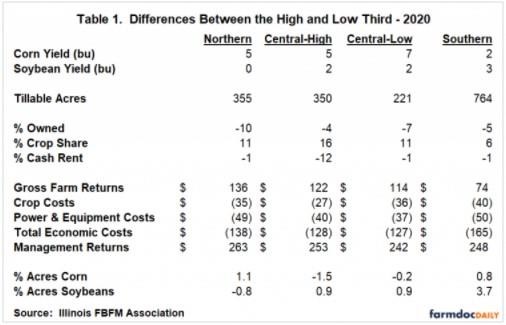By Bradley Zwilling
Illinois FBFM Association and Department of Agricultural and Consumer Economics
University of Illinois
Data from the Illinois Farm Business Farm Management Association (FBFM) for 2011 through 2020 was used to analyze selected differences between the highest profit grain farms (high one-third) and the lower profit grain farms (low one-third). The analysis was done for 2020 and for the 2011 through 2020 ten-year average. Farms in the higher profit group were larger, had higher corn yields, crop shared a larger percent of their acres, and had higher gross returns and lower costs. Management returns, a profit measurement, was significantly greater for the higher profit farms.


Farms are grouped by region in the state – north, central and south. The central region is also divided into a group of higher productive soils and a group with less productive soils. All farms were at least 500 acres in size with no or very limited livestock enterprises.
Crop Yields
The higher profit farms generally had higher corn and soybean yields. For 2020, the higher profit farms had higher corn yields ranging from 2 bushels per acre in southern Illinois to 7 bushels per acre in central Illinois with lower productive soils. Soybean yields were the same to 3 bushels per acre higher for the higher profit farms in 2020. The higher corn and soybean yields were the main factor for gross farm returns being $74 per acre to $136 per acre higher for the higher profit farms in 2020.
Similar results were found when comparing the 2011 through 2020 average for the higher one-third profit farms to the lower one-third profit farms. Corn yields were 9 bushels to 16 bushels per acre higher for the higher profit farms and soybean yields were 4 bushels to 6 bushels per acre higher. For the ten-year average comparison, gross farm returns were $104 to $132 per acre higher.
Crop Rotation
For 2020, a larger percent of the total acres were planted to corn for higher profit farms in northern and southern Illinois while in central Illinois the opposite was true with a smaller percent of the total acres planted to corn for higher profit farms. For the 2011 through 2020 average, northern and central Illinois higher profit farms planted a smaller percent of total acres to corn while the opposite was true for southern Illinois.
Also in 2020, higher profit farms in central and southern farms planted a larger percent of the acres to soybeans while a smaller percent of the acres were planted to soybeans in northern Illinois for high profit farms. For the 2011 through 2002 average, more profitable farms planted a larger percent of acres to soybeans statewide.
Farm Size
Farm size seems to be a contributing factor to the profitability as the higher profit farms were noticeably larger, generally from 200 to 800 acres larger depending on the period and the region in the state. The larger farms are able to spread their labor and machinery costs over more acres contributing to lower costs per acre and higher profitability.
Selected Expenses
Two expense categories were analyzed in the study, crop costs and power and equipment costs. Crop costs include fertilizer, seed and pesticides. The main power and equipment costs are fuel, repairs, machine hire and lease expense and economic depreciation. Crop costs were $27 to $40 per acre lower in 2020 for the different regions and $32 to $41 per acre less for the different regions for the 2011 through 2020 average comparison. Power and equipment costs were $40 to $50 per acre less in 2020 and $34 to $43 per acre less for the ten-year average comparison.
Management Returns
The combination of higher gross returns and lower costs per acre result in significantly higher management returns per acre for the higher profitable farms. For 2020, management returns were $242 to $263 per acre higher for the higher profitable farms and for the 2011 through 2020 average, management returns were $233 to $256 per acre higher.
Summary
Many factors contribute to some farms being more profitable than other farms. A few of these factors, such as weather, farm operators cannot control. However, many factors, such as crop and machinery costs, operators can control. As in past studies of this type, not one single factor is the main contributor to the difference in profitability, but many factors put together.
Source : illinois.edu